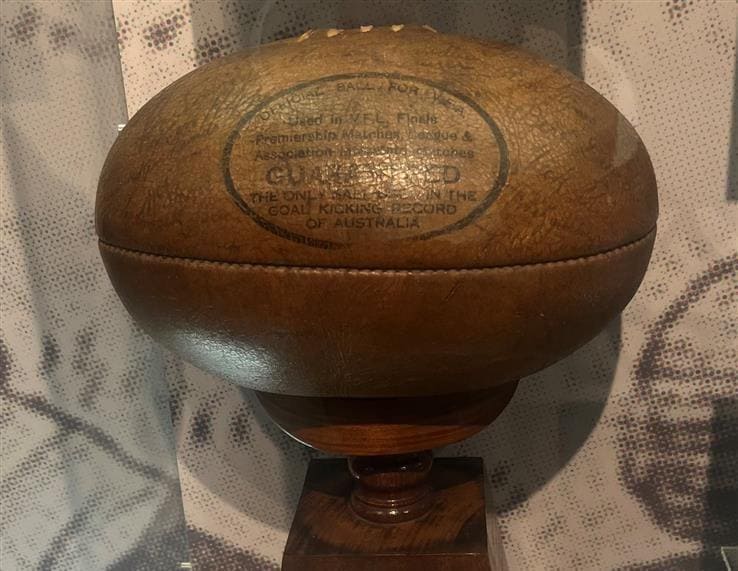Matchday football form ‘The Bloodbath’, signed by the then Carlton captain Bob Chitty and his men, currently on display at IKON Park
The late Jim Clark always remembered the passing comment of an ex-serviceman, one of the 63,000 who somehow crammed into Princes Park on the afternoon of the most infamous of all Grand Finals in 1945.
Said Clark: “Of ‘The Bloodbath’, I heard a fella say, ‘I was at the wrong war’.”
It’s 80 years ago today (September 29) since Carlton and South Melbourne engaged in what history records is the most spiteful of Grand Finals ever staged – ironically in the Year of Peace and Victory – before the greatest gathering of humanity for a game of football on Princes Park.
With the MCG a wartime base for the United States Army Air Forces, the Royal Australian Air Force, the US Marine Corps and the RAAF, Princes Park provided the venue for 62,986 people.
There they saw Carlton complete an incredible run of 13 victories from the final 14 matches (having at one point in the season been placed 12th and last with a percentage of 57.4%) – including the semi final win over North, the brutal Preliminary Final victory over Collingwood and of course the big one over the Bloods, 15.13 (103) to 10.15 (75).
The officiating field umpire Spokes worked overtime, for as history records, a total of nine players (six South Melbourne, three Carlton) were reported on a total of 15 charges arising from The Bloodbath, with a mammoth 72 matches worth of suspensions later imposed across the board.
How The Argus’ Percy Taylor reported The Bloodbath
The VFL Tribunal heard the charges on the Tuesday evening after the contest and made the following findings:
Ted Whitfield (South Melbourne), suspended until December 31, 1946 for his incident with goal umpire Les Whyte in the final quarter, in which he used abusive language, then attempted to strike Whyte, and ran down the field and lifted his guernsey to try to avoid being reported. Whitfield was the only reported player not to appear at the tribunal to defend himself; and a couple of weeks later was sacked by South. He was also suspended for two weeks for time-wasting by kicking the ball away after a free kick;
Jack Williams (South Melbourne), suspended for twelve weeks: eight weeks for fighting with Rod McLean, and four weeks for using abusive language towards the umpires;
Don Grossman (South Melbourne), suspended for eight weeks for striking Jim Mooring;
Jim Cleary (South Melbourne), suspended for eight weeks for striking Ken Hands, but cleared of a further charge of attempting to strike Bob Chitty;
Bob Chitty (Carlton), suspended for eight weeks for elbowing Bill Williams;
Ron Savage (Carlton), suspended for eight weeks for striking Don Grossman; and
Herbie Matthews (South Melbourne) was severely reprimanded for time-wasting by throwing the ball away after a free kick.
Carlton’s Ken Hands and South’s Keith Smith were the only two players found not guilty of their respective charges.
A subsequent investigation also saw Carlton’s Fred Fitzgibbon brought before the VFL committee. Fitzgibbon, who had been suspended for four matches for striking Collingwood’s Len Hustler in the Preliminary Final, had charged onto the field in his civvies on Grand Final day, in an attempt to strike a South player – only to be escorted from the ground by police.
Fitzgibbon was suspended for a further four matches.
The game drew condemnation in the media and headlines around the country for its savagery. The salacious Melbourne tabloid newspaper Truth declared the Grand Final “the most repugnant spectacle League football has ever known”, Perth’s the Call newspaper led with the headline “Carlton are Vic. ‘footbrawl’ premiers” and The Recorder in Port Pirie ran with “they kicked everything except the ball.”.
In the second round of 1946, moments before the opening bounce of the Carlton-Melbourne match at Princes Park, members of the two competing teams, together with the officiating umpires, lined up in V formation as Carlton President Ken Luke unfurled the ’45 flag.
Notable dignitaries there that day were the Premier John Cain, the League’s President Dr McLelland and, appropriately enough, Field Marshal Sir Thomas Blamey.
“They travelled early and far . . . ” Grand Final patrons, as pictured by The Herald’s photographer
Three weeks before, Blamey had stood with Douglas MacArthur on the deck of the USS Missouri and signed the Japanese surrender document on behalf of the people of Australia.
To the fighting men of Carton, this too was a significant day.

